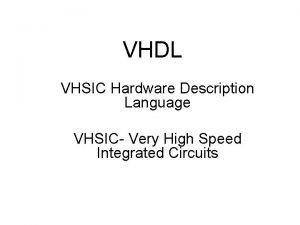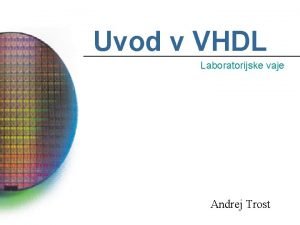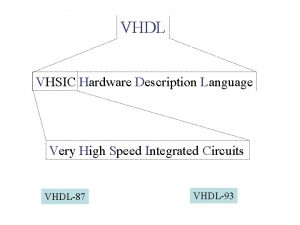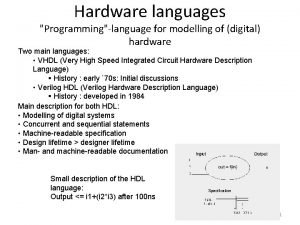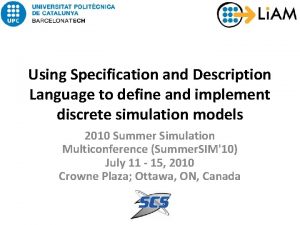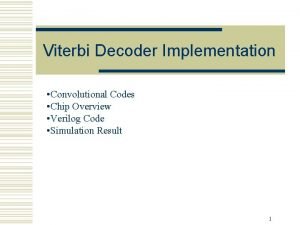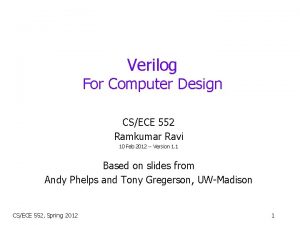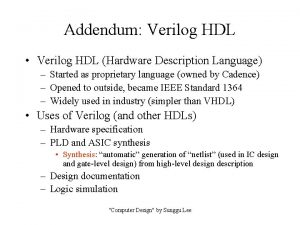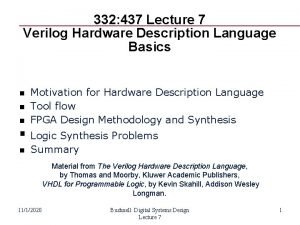The Verilog Hardware Description Language GUIDELINES n How
















































![ROM description (1/2) module rominfr (data, en, addr); output [3: 0] data; input en; ROM description (1/2) module rominfr (data, en, addr); output [3: 0] data; input en;](https://slidetodoc.com/presentation_image_h/30ce6c151d2b09abd376a4053568eae2/image-49.jpg)
![ROM description (2/2) initial begin ROM[0] = 4’b 0001; ROM[1] = ROM[2] = 4’b ROM description (2/2) initial begin ROM[0] = 4’b 0001; ROM[1] = ROM[2] = 4’b](https://slidetodoc.com/presentation_image_h/30ce6c151d2b09abd376a4053568eae2/image-50.jpg)

![DUAL –PORT RAM (2/2) always @(posedge clk 1) begin if (we) ram[add 1] <= DUAL –PORT RAM (2/2) always @(posedge clk 1) begin if (we) ram[add 1] <=](https://slidetodoc.com/presentation_image_h/30ce6c151d2b09abd376a4053568eae2/image-52.jpg)
![Include files `include "timing. vh" module counter 1(count, reset, clk) ; output [7: 0] Include files `include "timing. vh" module counter 1(count, reset, clk) ; output [7: 0]](https://slidetodoc.com/presentation_image_h/30ce6c151d2b09abd376a4053568eae2/image-53.jpg)
![Parametric models `include “rominfr_pkg. vh” module rominfr (data, en, addr); output [`wordlength-1: 0] data; Parametric models `include “rominfr_pkg. vh” module rominfr (data, en, addr); output [`wordlength-1: 0] data;](https://slidetodoc.com/presentation_image_h/30ce6c151d2b09abd376a4053568eae2/image-54.jpg)










- Slides: 64

The Verilog Hardware Description Language

GUIDELINES n How to write HDL code:

GUIDELINES n How NOT to write HDL code:

Think Hardware NOT Software n Poorly written HDL code will either be: – Unsynthesizable – Functionally incorrect – Lead to poor performance/area/power results

Conventions n Verilog IS case sensitive – CLOCK, clock and Clock are different n Syntax is based on C – but is interpreted differently

Verilog code basic structure module_name (ports); input_signals; output_signals; inout bidirectional signals; wire_signals; register_type_variables; primitive/component (ports); concurrent/sequential assignments endmodule

Port types n PORT DIRECTION - IN -OUT -INOUT n SIGNAL TYPE – scalar ( input x; ) – Vector (input [WIDTH -1 : 0] x)

Module port declaration example (1/2) module and_gate (o, i 1, i 2); output o; input i 1; input i 2; endmodule

Module port declaration example (2/2) module adder (carry, sum, i 1, i 2); output carry; output [3: 0] sum; input [3: 0] i 1, i 2; endmodule

Example

Verilog Primitives Verilog primitives are models of common combinational logic gates n Their functionality is built into the language and can be instantiated in designs directly n The output port of a primitive must be first in the list of ports n

Structural description example module gates (o, i 0, i 1, i 2, i 3); output o; input i 0, i 1, i 2, i 3; wire s 1, s 2; and (s 1, i 0, i 1); and (s 2, i 3); and (o, s 1, s 2); endmodule

Verilog operators • Arithmetic +, - , *, /, % • Bitwise & AND | OR ~ NOT ^ XOR ~^ XNOR Relational =, <, >, <=, >= • Synthesizable Non-synthesizable

User-Defined Primitives Truth Table Models primitive my_UDP (y, x 1, x 2, x 3); output y; //the output of a primitive cannot be a vector!! input x 1, x 2, x 3; table //x 1 x 2 x 3 : y 0 0 0 : 0; 0 0 1 : 1; 0 1 0 : 0; 0 1 1 : 0; 1 0 0 : 1; 1 0 1 : 0; 1 1 0 : 1; 1 1 1 : 0; endtable endprimitive

Truth tables with don’t cares table //? Represents a don’t care condition // on the input //i 1 i 2 i 3 : y 0 0 0: 0 0 0 1: 1 0: 0 0 1 1: 0 1 ? ? : 1 endtable

variable assignment variable_name = value; //blocking assignment variable_name <= value; //non-blocking assignment output a; output [6: 0] b; reg [3: 0] c; wire [2: 0] d; Correct a = 1; b <= 7’b 0101001; b[1] = 0; c <= 0; d <= {b , c}; b <= {c, d}; b[5: 2] <= c; Examples Incorrect a <= 3; b = 9’b 000011011; d <= 0;

Propagation delay Used to assign variables or primitives with delay, modeling circuit behaviour n # 5 and (s, i 0, i 1); -- 5 ns and gate delay n #5 assign s = i 0 & i 1; -- 5 ns and gate delay n #1 assign a = b; --1 ns wire delay Not synthesizable, is ignored by synthesis tools Useful in testbenches for creating input signal waveforms n always #20 clk = ~clk -- 40 ns clock period n #0 rst_n = 0; n #10 rst_n = 1;

Concurrent statements – delta time b = ~ a; (a = 1, b = 1, c =0) c = a ^ b; Time 0 δ 2δ a 1 1 1 b 1 0 0 c 0 0 1

Continuous assignment n Multiple driver error assign c = a & b; …. assign c = d | e;

Combinational circuit description module gates (d, a, c); output d; input a, c; //wire b; assign d = c ^ (~a); // assign b = ~a; // assign d = c ^ b; endmodule

Arithmetic unit description (full-adder) module add 1 (cout, sum, a, b, cin); input a, b; input cin; output sum; output cout; assign {cout, sum} = a + b + cin; endmodule

Example Describe a 5 -bit multiplier in Verilog.

Conditional assignment describing MUXs assign = select_signal ? assignment 1 : assignment 1 module mux (o, s, i 0, i 1); output o; input i 0, i 1; input s; assign o = s ? i 1 : i 0; //if s =1 then o = i 1, else o =i 0 endmodule

Cyclic behavior • • • Statements in cyclic behavior execute sequentially Can be used to describe either combinational circuits (optional) or sequential circuits (only way) Signals assigned in always blocks must be of type reg always & (sensitivity list) begin sequential statements end

Combinational Circuit Description using Cyclic Behavior always @ (a or b or c) begin d = (a & b) | c; end ALL input signals must be in sensitivity list or latches will be produced!

If statement (sequential)– describing MUXs if (condition 1) begin signal 1 <= value 1; signal 2 <= value 2; end else if (condition 2) begin signal 1 <= value 3; signal 2 <= value 4; end … else begin signal 1 <= valuen-1; signal 2 <= valuen; end module mux (o, s, i 0, i 1); output o; reg o; input i 0, i 1; input s; always @ (i 0 or i 1 or s) begin if (s == 0) o = i 0; else o = i 1; endmodule

CASE statement (sequential)– describing MUXs case (signal) value 1: signal 1 <= value 2; signal 2 <= value 3; value 2 : signal 1 <= value 4; signal 2 <= value 5; . . . default: signal 1 <= valuen-1; signal 2 <= valuen; endcase module mux (o, s, i 0, i 1); output o; reg o; input i 0, i 1; input s; always @ (i 0 or i 1 or s) begin case (s) 0: o = i 0; 1: o = i 1; default: o= 1’bx; endcase endmodule

Example n Describe a 3 -bit 4 -to-1 MUX

CLOCKED PROCESS (Latch with asynchronous reset) always @ (clk begin if (rst_n == q <= 0; else if (clk q <= d; end or rst_n) 0) == 1)

CLOCKED PROCESS (Latch with synchronous reset) always @ begin if (clk q <= else if q <= end (clk or rst_n) == 1) d; (rst_n == 0) 0;

CLOCKED PROCESS (Flip-flop with asynchronous reset) always @(posedge clk or negedge rst_n) begin if (rst_n == 0) q <= 0; else q <= d; end

CLOCKED PROCESS (Flip-flop with synchronous reset) always @(posedge begin if (rst_n == q <= 0; else q <= d; end clk) 0)

for loop statement – shift register module shift_reg (o, clk, rst_n, i); output o; input i; input clk, rst_n; reg [3: 0] d; integer k; always @ (posedge clk or negedge rst_n) begin if (rst_n ==0) d <= 0; else begin d[0] <= i; for (k=0; k <4; k=k+1) d[k+1] <= d[k]; end assign o = d[3]; endmodule

CLOCKED VS COMBINATIONAL PROCESS (1/2) always @ (a or b or c) begin case (c) 0: q = a; 1: q = b; default: q= 1’bx; endcase end always @ (posedge clk or negedge rst_n) begin if (rst_n == 0) q <= 0; else case (c) 0: q = a; 1: q = b; default: q= 1’bx; endcase end

CLOCKED VS COMBINATIONAL PROCESS (2/2) always @ (a or b or c) begin d = (a & b) | c; end always @ (posedge clk) begin if (rst_n == 0) d <= 0; else d <= (a & b) | c; end

EXAMPLE n DESCIBE A BINARY UP/DOWN COUNTER WITH ENABLE THAT COUNTS UPTO 12 AND THEN STARTS AGAIN FROM ZERO

TESTBENCH `timescale 1 ns / 100 ps module testbench_name (); reg …. ; //declaration of register variables for DUT inputs wire …; //declaration of wires for DUT outputs DUT_name(DUT ports); initial $monitor(); //signals to be monitored (optional) initial begin #100 $finish; //end simulation end initial begin clk = 1’b 0; #10 a = 1; … end //initialize clk always # 50 clk = ~clk; //50 ns clk period (if there is a clock) endmodule

TESTBENCH EXAMPLE `timescale 1 ns / 100 ps module mux_tb (); reg i 0, i 1, s; wire o; initial begin //stimulus pattern #10 i 0 = 0; i 1=0; s=0; #10 i 0=1; #10 i 0 = 0; i 1=1; #10 i 0=0; i 1= 0; s=1; mux M 1 (o, s, i 0, i 1); #10 i 0=1; #10 i 0 = 0; i 1=1; initial begin #10 i 0=1; #100 $finish; //end simulation end endmodule

FINITE STATE MACHINES

FINITE STATE MACHINE IMPLEMENTATION

Mealy machines (1/5) module fsm (y, clk, rst_n, x); output y; input clk, rst_n, x; reg [1: 0] state_pr, state_nx; reg y; parameter a = 0, b = 1, c = 2, d = 3, dont_care_state = 2’bx, dont_care_out = 1’bx;

Mealy machines (2/5) always @ (posedge clk or negedge rst_n) //state memory begin if (rst_n == 0) state_pr <= a; //default state else state_pr <= state_nx; end

Mealy machines (3/5) always @ (x or state_pr) //combinational part begin CASE (state_pr) a: if (x == 1) begin state_nx = b; y=0; end else if (x == 0) begin state_nx <= a; --optional y=0; end

Mealy machines (4/5) b: if (x == 1) begin state_nx = c; y=0; --Mealy machine end else if (x==0) begin state_nx <= a; y=0; --Mealy machine end c: if (x == 1) begin state_nx = c; --optional y=0; --Mealy machine end else if (x==0) begin state_nx <= d; y=0; --Mealy machine end

Mealy machines (5/5) d: if (x == 1) begin state_nx = b; y=1; --Mealy machine end else if (x==0) begin state_nx <= a; y=0; --Mealy machine end default: begin state_nx <= dont_care_state; y <= dont_care_out; endcase endmodule

Moore machines always @ (x or state_pr) --combinational part begin CASE (state_pr) s 0: y = <value>; --Moore machine if (a == 1) state_nx = s 1; else state_nx = s 0; --optional

MOORE MACHINES S 1: y = <value>; --Moore machine if (x == 1) state_nx = S 0; else state_nx = S 1; --optional endcase end

EXAMPLE: OUT-OFSEQUENCE COUNTER n DESCRIBE A COUNTER WITH THE FOLLOWING SEQUENCE: – “ 000” => “ 011” => “ 001” => “ 111” => “ 000”
![ROM description 12 module rominfr data en addr output 3 0 data input en ROM description (1/2) module rominfr (data, en, addr); output [3: 0] data; input en;](https://slidetodoc.com/presentation_image_h/30ce6c151d2b09abd376a4053568eae2/image-49.jpg)
ROM description (1/2) module rominfr (data, en, addr); output [3: 0] data; input en; input [4: 0] addr; reg [3: 0] ROM [31: 0]; assign data = ROM[addr];
![ROM description 22 initial begin ROM0 4b 0001 ROM1 ROM2 4b ROM description (2/2) initial begin ROM[0] = 4’b 0001; ROM[1] = ROM[2] = 4’b](https://slidetodoc.com/presentation_image_h/30ce6c151d2b09abd376a4053568eae2/image-50.jpg)
ROM description (2/2) initial begin ROM[0] = 4’b 0001; ROM[1] = ROM[2] = 4’b 0011; ROM[3] = ROM[4] = 4’b 0101; ROM[5] = ROM[6] = 4’b 0111; ROM[7] = ROM[8] = 4’b 1001; ROM[9] = ROM[10] = 4’b 1011; ROM[11] ROM[12] = 4’b 1101; ROM[13] ROM[14] = 4’b 1111; ROM[15] ROM[16] = 4’b 0010; ROM[17] ROM[18] = 4’b 0100; ROM[19] ROM[20] = 4’b 0110; ROM[21] ROM[22] = 4’b 1000; ROM[23] ROM[24] = 4’b 1010; ROM[25] ROM[26] = 4’b 1100; ROM[27] ROM[28] = 4’b 1110; ROM[29] ROM[30] = 4’b 0000; ROM[31] endmodule 4’b 0010; 4’b 0100; 4’b 0110; 4’b 1000; 4’b 1010; = 4’b 1100; = 4’b 1110; = 4’b 0001; = 4’b 0011; = 4’b 0101; = 4’b 0111; = 4’b 1001; = 4’b 1011; = 4’b 1101; = 4’b 1111; = 4’b 0001;

DUAL –PORT RAM (1/2) module v_rams_12 (clk 1, clk 2, we, add 1, add 2, di, do 1, do 2); input clk 1; input clk 2; input we; input [5: 0] add 1; input [5: 0] add 2; input [15: 0] di; output [15: 0] do 1; output [15: 0] do 2; reg [15: 0] ram [63: 0]; reg [5: 0] read_add 1; reg [5: 0] read_add 2;
![DUAL PORT RAM 22 always posedge clk 1 begin if we ramadd 1 DUAL –PORT RAM (2/2) always @(posedge clk 1) begin if (we) ram[add 1] <=](https://slidetodoc.com/presentation_image_h/30ce6c151d2b09abd376a4053568eae2/image-52.jpg)
DUAL –PORT RAM (2/2) always @(posedge clk 1) begin if (we) ram[add 1] <= di; read_add 1 <= add 1; end assign do 1 = ram[read_add 1]; always @(posedge clk 2) begin read_add 2 <= add 2; end assign do 2 = ram[read_add 2]; endmodule
![Include files include timing vh module counter 1count reset clk output 7 0 Include files `include "timing. vh" module counter 1(count, reset, clk) ; output [7: 0]](https://slidetodoc.com/presentation_image_h/30ce6c151d2b09abd376a4053568eae2/image-53.jpg)
Include files `include "timing. vh" module counter 1(count, reset, clk) ; output [7: 0] count; input reset, clk; reg [7: 0] count; always @(posedge clk or posedge reset) if(reset) count <= #(`REG_DELAY) 8'b 0; else count <= #(`REG_DELAY) count + 8 'b 1; . . . n //contents of ”timing. vh” file `timescale Ins/Ins `define REG_DELAY 1
![Parametric models include rominfrpkg vh module rominfr data en addr output wordlength1 0 data Parametric models `include “rominfr_pkg. vh” module rominfr (data, en, addr); output [`wordlength-1: 0] data;](https://slidetodoc.com/presentation_image_h/30ce6c151d2b09abd376a4053568eae2/image-54.jpg)
Parametric models `include “rominfr_pkg. vh” module rominfr (data, en, addr); output [`wordlength-1: 0] data; input en; input [`addr_size-1: 0] addr; reg [`wordlength-1: 0] ROM [`ROM_size-1: 0]; . . . //contents of “rominfr_pkg. vh” `define wordlength 8 `define addr_size 5 `define ROM_size 32

Example n n n n n Create an ALU with parametric wordlength, and the following function table S 2 S 1 S 0 FUNCTION 0 0 0 A+B 0 0 1 A–B 0 1 0 A+1 0 1 1 B+1 1 0 0 A AND B 1 0 1 A OR B 1 1 0 A XOR B 1 1 1 NOT A

Common Verilog Pitfalls

Name inconsistency Compile: error n Severity: Trivial n module wrong_name (o, i 0, i 1, i 2); output o; input i 1, i 2, i 3; assign o = i 0 & i 1 ^ i 2; endmodule

Multiple unconditional concurrent assignments n n n Simulation: ‘X’ value Synthesis: ERROR: signal is multiply driven Severity: Serious module … assign x = a & b; . . . assign x = b ^ c; always @ (b or c) begin x <= b | c; end

Incomplete sensitivity list n n Simulation: Unexpected behavior Synthesis: Warning: Incomplete sensitivity list Severity: Serious Solution: complete sensitivity list always @ (a or b) begin d <= (a & b) | c; //c is missing from sensitivity list!!! end

Not assigning all outputs in combinational always block n n Simulation: Synthesis: Warning: Signal not always assigned, storage may be needed Severity: Serious Solution: assign all signals always @ (a or b or c) begin if (c == 0) then d <= (a & b) | c; //d assigned only first time, else if (c == 1) e <= a; //e assigned only second time!!! end

Unassigned signals Simulation: Undefined value (‘U’) n Synthesis: Warning: Signal is never used/never assigned a value n Severity: Moderate n module … output y; input 1, input 2; wire s; assign y = input 1 & input 2; //s never assigned endmodule

Output not assigned or not connected Simulation: Undefined n Synthesis: Error: All logic removed from the design n Severity: Serious n module my_module (o, input 1, input 2); output o; input 1, input 2; wire s; assign s = input 1 & input 2; //output never assigned endmodule

Using sequential instead of concurrent process Simulation: Unexpectedly delayed signals n Synthesis: More FFs than expected n

Confusing reg with wire module my_module (o, input 1, input 2); output o; input 1, input 2; assign o = input 1 & input 2; //output is wire by default endmodule my_module (o, input 1, input 2); output o; reg o; input 1, input 2; always @ (input 1 or input 2) //using always block o = input 1 & input 2; //output must be reg endmodule
 The verilog® hardware description language
The verilog® hardware description language What is hdl hardware description language
What is hdl hardware description language Vhsic hardware description language
Vhsic hardware description language Vhsic hardware description language
Vhsic hardware description language Hardware description language
Hardware description language Vhsic hardware description language
Vhsic hardware description language Verilog
Verilog Behavioral description verilog
Behavioral description verilog External hardware
External hardware Language
Language Hardware programming language
Hardware programming language Hình ảnh bộ gõ cơ thể búng tay
Hình ảnh bộ gõ cơ thể búng tay Bổ thể
Bổ thể Tỉ lệ cơ thể trẻ em
Tỉ lệ cơ thể trẻ em Chó sói
Chó sói Tư thế worm breton là gì
Tư thế worm breton là gì Alleluia hat len nguoi oi
Alleluia hat len nguoi oi Kể tên các môn thể thao
Kể tên các môn thể thao Thế nào là hệ số cao nhất
Thế nào là hệ số cao nhất Các châu lục và đại dương trên thế giới
Các châu lục và đại dương trên thế giới Công của trọng lực
Công của trọng lực Trời xanh đây là của chúng ta thể thơ
Trời xanh đây là của chúng ta thể thơ Mật thư anh em như thể tay chân
Mật thư anh em như thể tay chân Phép trừ bù
Phép trừ bù Phản ứng thế ankan
Phản ứng thế ankan Các châu lục và đại dương trên thế giới
Các châu lục và đại dương trên thế giới Thể thơ truyền thống
Thể thơ truyền thống Quá trình desamine hóa có thể tạo ra
Quá trình desamine hóa có thể tạo ra Một số thể thơ truyền thống
Một số thể thơ truyền thống Cái miệng bé xinh thế chỉ nói điều hay thôi
Cái miệng bé xinh thế chỉ nói điều hay thôi Vẽ hình chiếu vuông góc của vật thể sau
Vẽ hình chiếu vuông góc của vật thể sau Thế nào là sự mỏi cơ
Thế nào là sự mỏi cơ đặc điểm cơ thể của người tối cổ
đặc điểm cơ thể của người tối cổ Ví dụ về giọng cùng tên
Ví dụ về giọng cùng tên Vẽ hình chiếu đứng bằng cạnh của vật thể
Vẽ hình chiếu đứng bằng cạnh của vật thể Fecboak
Fecboak Thẻ vin
Thẻ vin đại từ thay thế
đại từ thay thế điện thế nghỉ
điện thế nghỉ Tư thế ngồi viết
Tư thế ngồi viết Diễn thế sinh thái là
Diễn thế sinh thái là Dạng đột biến một nhiễm là
Dạng đột biến một nhiễm là Số nguyên tố là gì
Số nguyên tố là gì Tư thế ngồi viết
Tư thế ngồi viết Lời thề hippocrates
Lời thề hippocrates Thiếu nhi thế giới liên hoan
Thiếu nhi thế giới liên hoan ưu thế lai là gì
ưu thế lai là gì Hổ sinh sản vào mùa nào
Hổ sinh sản vào mùa nào Sự nuôi và dạy con của hươu
Sự nuôi và dạy con của hươu Hệ hô hấp
Hệ hô hấp Từ ngữ thể hiện lòng nhân hậu
Từ ngữ thể hiện lòng nhân hậu Thế nào là mạng điện lắp đặt kiểu nổi
Thế nào là mạng điện lắp đặt kiểu nổi Object description language
Object description language Database ddl
Database ddl Sql languages in dbms
Sql languages in dbms Is the standard page description language for web pages
Is the standard page description language for web pages Sdl specification and description language
Sdl specification and description language Viterbi decoder verilog code
Viterbi decoder verilog code Greg edmiston
Greg edmiston Verilog vs vhdl
Verilog vs vhdl 게이트 프리미티브
게이트 프리미티브 Verilog quick reference
Verilog quick reference Verilog always if문
Verilog always if문 Non synthesizable constructs in verilog
Non synthesizable constructs in verilog


